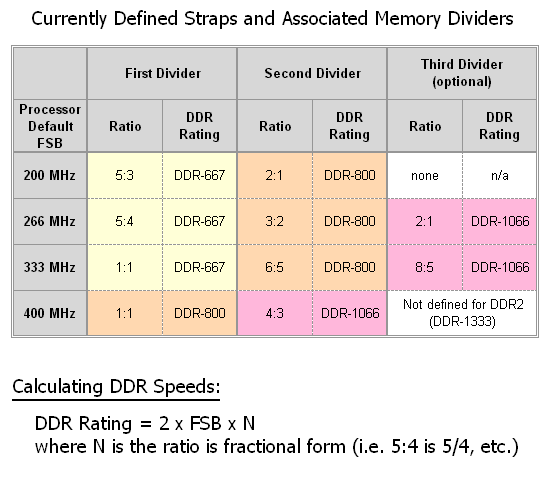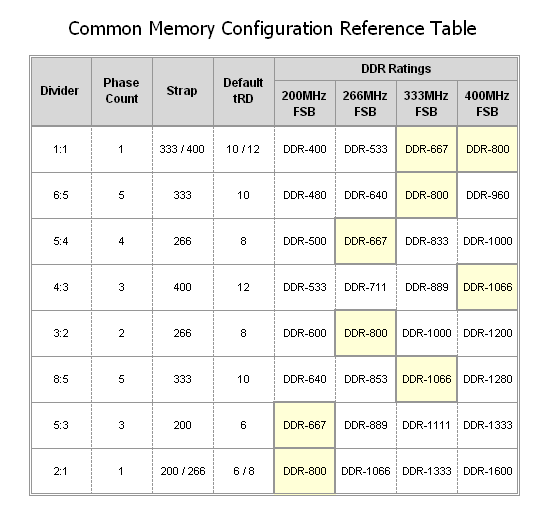ASUS ROG Rampage Formula: Why we were wrong about the Intel X48
by Kris Boughton on January 25, 2008 4:30 AM EST- Posted in
- Motherboards
The Basics of Strap Selections, Dividers and Derived Memory Speeds
We have discussed MCH Read Delay (tRD) and its effects on memory read performance before. About a year ago, this particular setting allowed some vendors to design boards that seemed to outperform competing companies' products consistently on a clock-for-clock basis. This was around the time that the enthusiast community first realized the importance of "straps". Some found that by setting a lower strap while running an equivalent Front Side Bus (FSB) that they were able to achieve better performance, higher frame rates, and better benchmark completion times all without the help of any additional tuning.
For those that are unfamiliar with what we mean by strap, consider the following example. Suppose you have two different CPUs, each with a different default FSB, as is the case with first-generation Core 2 processors (266MHz) and current 45nm Core 2 processors (333MHz). If you were to install these processors in identical systems each would be capable of running the same memory speeds (at least DDR2-667 and DDR2-800), regardless of the processor's default FSB. For the 266MHz default FSB processor, this would require a 5:4 and 3:2 divider respectively, while the 333MHz FSB variant would need 1:1 and 6:5. These ratios are necessary in order for the motherboard to set up allowable memory subsystem to system data bus interface configurations.

Because of this, the motherboard does not need to know anything about the installed processor and memory, other than the default FSB and the memory's SPD rating, which are both read programmatically prior to Power On Self Test (POST). For example, a 266 FSB processor paired with DDR2-800 memory will make use of the associated 266 strap's second divider - as would a 333 FSB processor. Would you be surprised to learn this works exactly the same way for a 200 FSB processor? Well, it does, and in fact it does not matter which processor type is installed - all combinations work and allow for the same exact memory speeds - DDR2-667 and DDR2-800 (and sometimes DDR2-1066).
If slower memory is detected the system simply uses the first divider in order to achieve DDR2-667 speeds. In the case of faster memory, the third divider is used for DDR2-1066 - which is sometimes available, depending on the strap in use. (All 266, 333, and the upcoming 400 MHz FSB parts will be able to make use of this new official memory speed, as recently announced by JEDEC.) One final note, "down" dividers are no longer possible with Intel platforms and as such the lowest supported memory speed for systems that will make use of the QX9770 (when it arrives) will be DDR2-800, unless the user chooses to underclock the FSB.
As we can see, this system allows for maximum component interchangeability and configuration flexibility all through the use of relatively straightforward selection logic. Check the table below for more information on how to derive these numbers.

Now that we know a little more about what straps are and how they work, we are ready to discuss what they mean when overclocking. Let's say you have an E6700 that makes use of a default FSB of 266MHz - pushing the FSB to 400 while making use of the processor's default strap's second divider (3:2) results in a final memory speed of DDR2-1200, a goal that might be outside the realm of normal achievement unless you have memory capable of this speed. By selecting the 400 strap the 1:1 and 4:3 dividers become available and we are able to set a more modest speed of either DDR2-800 or even DDR2-1066. Alternatively, choosing the 266 strap permits use of the 5:4 divider for DDR2-1000.
The point is that the freedom to choose any strap we want, regardless of CPU type installed, gives us the choice to make use of a whole myriad of memory speed settings that would otherwise be unavailable. Take note of the "Default tRD" column; you will see that each strap has an associated value (6 at the 200 strap, 8 for 266, etc.) We will discuss this particular setting in detail a little later.
Until now, choosing a memory divider in order to set a final memory speed was easy. Most users focus solely on achieving maximum CPU frequency, letting the memory speed fall where it will. Although it is possible for memory to be the limiting component when overclocking, this is unlikely considering the low cost and high availability of today's performance DDR2 modules. Thus it's easy to pick a memory divider that places the memory operating point near a maximum without ever considering what could be done in order to further improve performance.
Perhaps too many users feel the time they need to invest in fine-tuning their memory settings is not worth the effort. While this might not be far from the truth, we find this hard to believe. Major memory manufactures like OCZ, Corsair, Cell Shock, G.Skill, and Team Group have entire departments of support personnel that work hard every day to provide users the assistance they need to make the most of their purchase. These groups are inundated with requests for help, from both experienced users and novices alike.
Going back to what we said before, what does all of this have to do with better performance on a clock-for-clock basis? In a word: everything! We would like to provide some solid information on the subject as to why the age-old quest for maximum FSB is not always the best approach; in fact, it is often the wrong approach. Our hope is that once allowed an opportunity to make use of this information, users will begin to understand the true limitations of their system components better and might perhaps stop inappropriately blaming overclocking failures on perfectly good hardware. Better yet, they'll stop buying boards based solely on FSB capability when overall system performance is much more important.
Now that we have had a chance to review the basics on memory straps let's move on to something a little more interesting - MCH clock crossing operation and the associated MCH Read Delay (tRD).










73 Comments
View All Comments
kjboughton - Sunday, January 27, 2008 - link
The rules as defined may not apply exactly as provided for P35. The equations have been tested to be true for X38/X48 but additional testing is still needed on P35 in order to validate the results.Super Nade - Saturday, January 26, 2008 - link
Hi,I love the technical depth of the article. Outstanding writeup! I hope you will NOT dumb down future articles as this is how, IMO a review should be written.
S-N
Eric Rekut - Saturday, January 26, 2008 - link
Great article! I have a question, is x48 faster in super-pi than p35/x38?Rajinder Gill - Saturday, January 26, 2008 - link
Hi,In general the X38/X48 chipset outscores the P35 in Super Pi. The x48 can/will pull ahead of the X38 very marginally IF it can handle a lower overall tRD with a higher FSB combination and tighter memory sub-timing ranges - within an available level of Northbridge voltage.
regards
Raja
Rob94hawk - Saturday, January 26, 2008 - link
I would love to see you guys do benchmarking and overclocking with the QX9770+DDR3 1800 with this mobo.Rajinder Gill - Saturday, January 26, 2008 - link
Hi Rob,Kris will be testing the Rampage Extreme soon (with DDR3). The 9770's only show a little more prowess than QX9650's under LN2 cooling (in some instances - not always). With cascade/water/air cooling there's little to separate the QX9650 from the QX9770 (at least in my experience with both processors thus far).
regards
Raja
enigma1997 - Saturday, January 26, 2008 - link
Another excellent article after the QX9650 O/C one. Congratulations!!I have a few questions: What ram did you use to achieve the amazingly high bandwidth result (the one that goes with the 450FSB and tRD 5)? I understand you are using a divider of 3:2 and CAS5, so I expect the DDR2 speed should be at 10800!!
Also, I am not sure how you can get a memory read of >9000MB/s with tRD 5. I have a pair of G.Skill F2-8000PHU2-2GBHZ 4-4-4-5 and a DFI X38-T2R motherboard. I set it up with a QX9650 with tRD/FSB/ram timing identical to yours, but I only get around 8800MB/s. Note that the CPU runs at 3000Mhz.
Thanks for the article and your answers to my questions :)
kjboughton - Sunday, January 27, 2008 - link
Memory used for the incredible 450FSB/tRD 5 result was OCZ DDR2 PC-9200 Reaper (2GB kit).Regarding the testing you did at equivalent speeds, contrary to popular belief, CPU speed does influence both system memory read latency and bandwidth (add 16 clocks of whatever the CPU's Tcycle is to total system latency - about an extra 1.33ns going from 4GHz, where I tested, down to 3GHz uses in your system). This is certainly enough to reduce your BW results down below 9GB/s.
Jodiuh - Saturday, January 26, 2008 - link
"we feel there is nothing that needs modification by the end user as long as overclocking aspirations are within reason."The current Maximus series requires a bit of work (heatgun, fridge) to pull this off and replace with TIM of choice. Also I noticed a 7C drop on the bench when adding a 5CFM 40mm to the NB. Would you mind fleshing out the comment a bit more?
Thanks for the very thorough information in the article!
jedisoulfly - Friday, January 25, 2008 - link
there is a patriot viper ddr3 1600 cl7 kit at newegg for $295 (out of stock at time of this post) that is dramatically higher than good 800 ddr2 or even 1066 but just over a year ago ddr2 800 2gb kits were going for that price. I think once NV and AMD start making chip sets that support ddr3 the prices will start to come down...hopefully